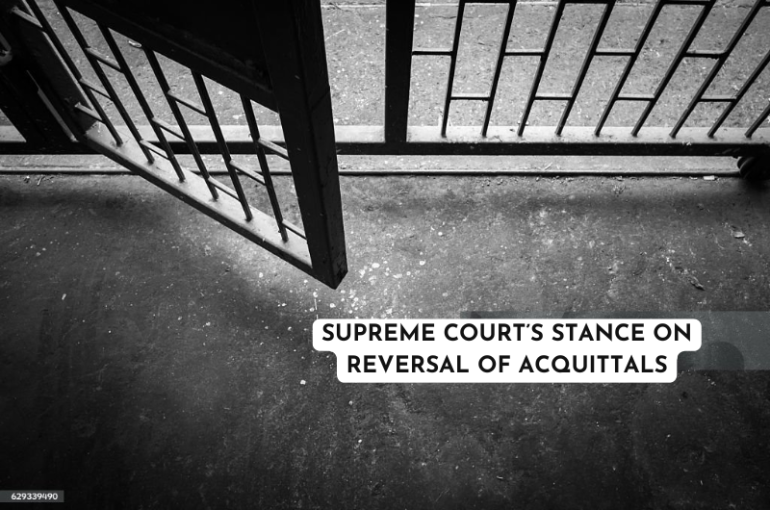SUPREME COURT’S STANCE ON REVERSAL OF ACQUITTALS
Introduction
The Supreme Court of India recently delivered a landmark judgment by a Bench of Justice Bela M. Trivedi And Justice Satish Chandra Sharma, in the case of Vijay Singh @ Vijay Kumar Sharma vs. The State of Bihar [CRIMINAL APPEAL NO. 1031 OF 2015], where it critically examined the standards for reversing acquittals and the need for concrete evidence in criminal trials. The case revolved around the abduction and murder of Neelam in 1985, allegedly motivated by a property dispute.
Facts of the Case
In 1985, Neelam, the Deceased, was allegedly abducted from her residence by a group of seven men. This incident was reported by her brother-in-law, leading to the lodging of an FIR. The chargesheet filed by the Police named seven Accused.
The motive for the crime, as presented by the Prosecution, was related to a property dispute over the house of Neelam’s late father, in which the Accused allegedly sought to take possession by abducting and killing Neelam.
The Trial Court convicted Accused Nos. 1 to 5 for the offences under Sections 302/34 and 364/34 of the Indian Penal Code (IPC) and acquitted A-6 and A-7 due to insufficient evidence. The High Court upheld the convictions of Accused Nos. 1 to 5 but reversed the acquittal of A-6 and A-7, finding them guilty of the same offences.
Issues
1) Whether the High Court was justified in reversing the acquittal of A-6 and A-7 and convicting them for the offences under Sections 364/34 and 302/34 IPC.
2) Whether the evidence presented by the Prosecution was sufficient to prove the involvement of the Accused in the commission of the offences.
High Court’s Analysis
The High Court reasoned that the testimonies of key prosecution witnesses were consistent in implicating all the accused, including A-6 and A-7, in the abduction and subsequent murder of Neelam. It held that the Trial Court had erroneously acquitted A-6 and A-7 based on the testimony of PW5, which the High Court found unreliable. The High Court concluded that the evidence demonstrated a common intention among all accused to commit the crime, justifying the reversal of the acquittal and sentencing A-6 and A-7 to rigorous life imprisonment.
Supreme Court’s Verdict
The Supreme Court noted that the testimonies of Prosecution Witnesses were contradictory and unreliable. Their presence at the crime scene was doubtful as they had no plausible reason to be there. The Supreme Court observed that their testimonies were not corroborated by any independent witnesses, even though several were available, such as the neighbours and tenants in the house.
The Hon’ble Court questioned whether Neelam was actually residing at the house at the time of her alleged abduction. The Prosecution failed to provide conclusive evidence of her residence, and the presence of other tenants in the house was not sufficiently considered. The Court criticized the High Court’s reasoning regarding the presence of make-up articles as evidence of Neelam’s residence.
The discrepancy in the time of death, as suggested by the post-mortem report, raised further doubts. The report indicated that the death occurred around 5:00 PM on August 30, 1985, whereas the Prosecution claimed the incident took place at 10:00 PM. This discrepancy undermined the Prosecution’s timeline of events.
The Supreme Court held that the High Court did not provide a valid legal basis for overturning the acquittal of Accused no 6 and 7. It failed to demonstrate that the Trial Court’s view was unreasonable or that it had overlooked significant evidence. The mere possibility of an alternative view did not justify reversing the acquittal.
Judgment
The Supreme Court set aside the conviction of all the Accused, including the reversal of acquittal for A-6 and A-7 by the High Court. The Supreme Court set aside the High Court’s order due to unreliable eyewitness testimonies, discrepancies in the timeline of events, and insufficient circumstantial evidence. The Court found contradictions in the prosecution’s narrative, including doubts about the presence of the accused and the deceased’s residence at the crime scene. It emphasized the need for a higher standard of proof to overturn acquittals and reaffirmed the presumption of innocence, noting that the High Court failed to provide compelling reasons to reverse the Trial Court’s acquittal of A-6 and A-7. Consequently, all accused were acquitted.
Note:
Section 364: This section deals with kidnapping or abducting someone with the intent to murder them or put them in danger of being murdered. The punishment for this offense is death or imprisonment for life, along with a fine.
Section 34: This section deals with joint liability, which states that when multiple people commit a criminal act with a common intention, each person is liable for the offense as if they had committed it alone.
Section 302: This section deals with the punishment for murder.
Ashita
Associate
The Indian Lawyer & Allied Services





































Leave a Reply